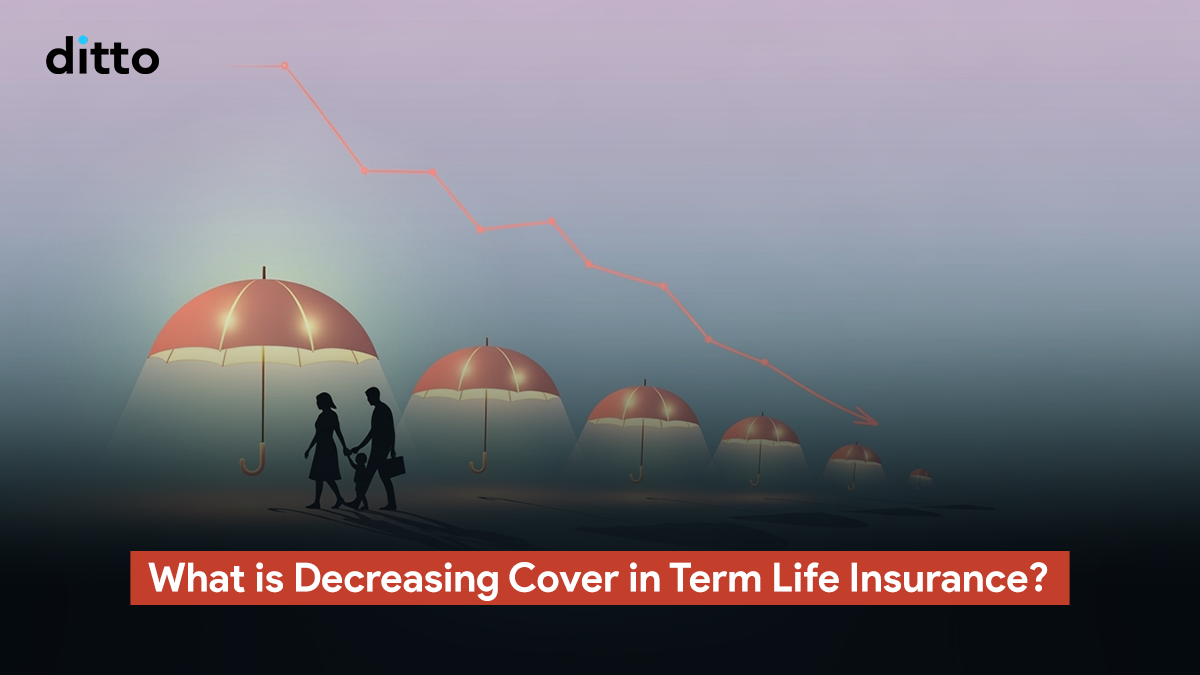| What is the Decreasing Cover Option in Term Insurance Plans? The decreasing cover option in term insurance reduces the sum assured over time, often aligned with fixed liabilities like home or business loans. While this makes premiums slightly cheaper, the reduced protection can leave families financially exposed since expenses and responsibilities usually grow rather than shrink. Decreasing cover works only in specific cases, such as loan protection, but is unsuitable for long-term family security. Alternatives like level cover, increasing cover, or zero-cost exit options offer better protection. At Ditto, we recommend level term plans as they provide stable, predictable coverage that aligns with real-life financial needs. |
Choosing the right cover amount in a term insurance plan isn’t always straightforward. You need to consider your age, income, dependents, and liabilities. But here’s a common dilemma our advisors often hear: “If my expenses and responsibilities are going to reduce in the future, why should I lock myself into a high cover for the entire policy period?”
The answer to this lies in understanding a unique feature available with some policies: the decreasing cover option.
While the term is self-explanatory, there are still many factors you need to be aware of if you’re unsure about choosing the right cover amount for your term insurance plan. In this article, we will break down what a decreasing cover option is, how it works, its pros and cons, and whether you should consider it at all.
Comparing policies and premiums can be overwhelming. Save time. Get free, personalized advice from Ditto with zero spam. Just 30 minutes to clear all your doubts. Book your free call now!
What is a Decreasing Cover Option in Term Insurance Plans?
As the name suggests, a decreasing cover option in term insurance means the sum assured reduces gradually over the policy term. It is usually linked to fixed financial liabilities such as home or business loans. This option can work if your insurance need is tied to a debt, but may not suit long-term family protection since expenses often grow over time.
How Does Decreasing Cover Option Work in a Term Insurance Policy?
A decreasing term plan reduces your sum assured over time to match specific liabilities like a home loan. However, if your financial needs don’t reduce as expected, this option may leave you under-protected. For this example, we are taking up one of the popular term insurance policies in the industry: HDFC Life Click2Protect Supreme. The Decreasing Cover option in this policy is called the Life Goal perk.
Let’s take the case of a 38-year-old professional with a spouse aged 35 and a 10-year-old child. To secure his family’s future, he buys term insurance with a ₹2 crore cover till age 65 under HDFC’s Click2Protect Supreme, opting for a 15-year limited pay. The decreasing cover costs ₹37,539 annually, compared to ₹50,391 for the level cover.
But here’s the catch: from the 5th year, the cover starts reducing by about ₹10 lakh each year. By the later years, it falls from ₹2 crore to just ₹10 lakh—right when family expenses are likely to be at their peak.
But the reality is more complex. His spouse may still depend on him financially until retirement age, and ongoing commitments such as lifestyle expenses, retirement savings, or even loan repayments may continue. By the time his child is in college and expenses are at their peak, the protection that started at ₹2 crore has already shrunk to a level that could leave his family dangerously under-protected.
The lesson? Lower premiums may look appealing, but a decreasing cover can leave your family exposed just when they need financial protection the most.
So, with a decreasing cover option, the sum assured keeps reducing over time, but the premiums stay fixed. Compared to a level cover term plan, the premiums are usually lower. While it sounds like a lucrative perk considering the chances of reduced financial support requirements after your retirement years, the feature is not without its set of downsides. If you’d like to explore suitable options, you can check out our list of the most popular term plans here.
Why Do Some People Consider Decreasing Coverage?
At first glance, a decreasing cover looks appealing because premiums are slightly lower than a standard level cover plan. People usually consider it when:
- Covering loans: As EMIs reduce and debts get repaid, the need for a large cover also goes down.
- Business liabilities: business owners may use it to cover small, short-term debts.
However, outside of these specific cases, most people’s financial responsibilities don’t really shrink, they often grow. That’s why this option may not work well for long-term family protection.
| Did You Know? Decreasing cover is common in credit or home loan insurance, where the payout reduces along with your outstanding loan. Lenders often bundle these policies with loans, but they are not mandatory. You are free to choose a regular term plan with level cover, which can offer more flexibility and better value. |
What Are the Limitations of a Decreasing Cover Option?
While a decreasing cover may seem attractive, it comes with some clear drawbacks you should know about:
1. The savings aren’t worth it: While decreasing cover may look cheaper, term insurance premiums are already quite affordable. For example, a healthy 25-year-old can get ₹1 crore cover till age 65 for just ₹10,000–₹12,000 annually. Cutting down your family’s protection to save a small fraction of this cost doesn’t really make sense.
2. Coverage needs go beyond loans: Debts like EMIs are only one part of your financial picture. A term plan’s real purpose is to replace your income and secure your family’s future. This includes children’s education, your spouse’s needs, support for parents, and rising costs due to inflation. A decreasing cover may leave your family vulnerable to these ongoing expenses. While a decreasing cover might suit very specific needs, a standard level term plan usually offers far more reliable protection for your family.
Decreasing Cover vs. Zero-Cost Exit and Increasing Cover Options
Decreasing term insurance was once marketed as a cheaper way to match reducing liabilities, like home loans. The cover amount gradually reduces over the years, which may seem practical if your goal is only to cover debts. But outside of that, most people’s financial responsibilities don’t really shrink, they often grow.
This leaves families under-protected in the long run.With the arrival of zero-cost exit features, the appeal of decreasing cover has faded. These plans let you maintain a constant level of cover throughout the term.
If your responsibilities genuinely decline, you can exit early (say after 25 or 30 years) and receive most of your premiums back. In short, you get maximum protection for as long as you need it, with the flexibility to step away later.
For a detailed breakdown, you can read our article on zero-cost term plans here.
Why a Consistent or Increasing Cover Makes More Sense?
Unlike a decreasing cover, most reputed insurers today recommend options that either keep your coverage consistent or even increase it over time. This approach reflects real-life needs because financial responsibilities rarely shrink, and inflation only raises the cost of maintaining the same lifestyle. Features like life stage benefits or increasing cover options allow you to scale up your protection as your responsibilities grow, ensuring that the sum assured stays relevant throughout your life.
In contrast, a reducing cover works against this reality. Over time, your family could end up with a much smaller payout that may not align with their actual financial needs. Term insurance is already affordable, so cutting back on coverage for the sake of slightly lower premiums can leave your loved ones vulnerable in the long run.
When Does a Decreasing Cover Option Make Sense?
A decreasing cover makes sense only in very specific situations. For instance, if your goal is to cover a particular loan with a fixed tenure and you already have a separate comprehensive term plan in place, then a reducing cover may work. Another case could be when the final reduced sum assured still comfortably meets your family’s minimum financial needs based on their lifestyle and expenses. For example, if your actual requirement is around ₹3 crore and you choose a decreasing plan starting at ₹5–6 crore, the eventual drop in cover would not necessarily leave your family underinsured.
Ditto’s Take on the Decreasing Cover Option
At Ditto, we believe the best choice is to begin with a level term plan because it provides stable and predictable protection for your family. If you cannot afford the ideal cover right away, you can always expand your protection later by purchasing an additional plan or using life-stage upgrade options. Decreasing cover, on the other hand, is rarely suitable and should only be considered if your goal is to protect a specific loan while maintaining a separate plan for your family’s needs. As a simple rule, a sufficient level of coverage is better than an increasing coverage, which in turn is better than a decreasing coverage.
Why Choose Ditto for Term Insurance
At Ditto, we’ve assisted over 7,00,000 customers with choosing the right insurance policy. Why customers like Shikhar love us:

✅No-Spam & No Salesmen
✅Rated 4.9/5 on Google Reviews by 15,000+ happy customers
✅Backed by Zerodha
✅100% Free Consultation
✅Personalized recommendations
✅Real-time claim support
You can book a FREE consultation here. Slots are running out, so make sure you book a call now.
Conclusion
Decreasing cover may sound appealing because of its slightly lower premiums, but in reality, it often leaves families under-protected. Most insurers don’t even promote it widely, as it doesn’t align well with long-term financial security.
Key Takeaways:
- Premium savings are minimal compared to the risk of reduced protection.
- Decreasing cover works only for very specific goals like loan protection.
- For family security, level or increasing cover is a much safer choice.
- Inflation and ongoing expenses make consistent or rising cover more practical.
A decreasing cover option usually defeats the main purpose of term insurance, long-term financial protection for your loved ones.
FAQs
Is a decreasing cover option cheaper than a regular term plan?
Yes, decreasing cover term plans usually have slightly lower premiums than level cover plans. However, the difference is not very significant, and the reduced protection may not justify the savings.
Who should consider a decreasing cover option in term insurance?
This option works only if your insurance needs are tied to a specific liability, like a home loan or business loan. For most people, a level or increasing cover is better because family expenses and financial responsibilities rarely reduce over time.
Can I switch from a decreasing cover to a level cover later?
No, once chosen, the cover type is fixed for the policy term. If you want flexibility, you should look at plans that offer features like a zero-cost exit option or an increasing cover benefit instead.
Last updated on:










